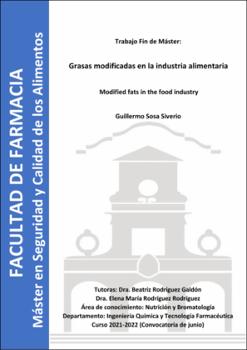Grasas modificadas en la industria alimentaria
Author
Sosa Siverio, GuillermoDate
2022Abstract
Las grasas de origen vegetal y animal, en su estado natural, ofrecen una serie de usos
limitados para la industria alimentaria. La modificación de las estructuras de
triacilglicerol de las grasas permite mejorar sus características tecnológicas y aumentar el
número de aplicaciones y productos que hacen uso de estas, mediante procesos
convencionales (hidrogenación, fraccionamiento e interesterificación química) y no
convencionales (interesterificación enzimática, modificación genética, oleogelificación,
uso de sustitutos de grasas no lipídicos, etc.) de modificación de lípidos. La comprensión
de las reacciones y condiciones que se dan en cada proceso son claves para la
optimización de los productos obtenidos. El fraccionamiento en seco y la
interesterificación enzimática son técnicas que han sido especialmente investigadas y
aplicadas industrialmente en años recientes, debido a las numerosas ventajas que ofrecen.
Sin embargo, ninguna de las técnicas estudiadas está exenta de problemas y limitaciones.
Palabras clave: grasas modificadas; hidrogenación; ácidos grasos trans;
fraccionamiento; interesterificación. Fats of vegetable and animal origin, in their native state, offer several limited uses for the
food industry. Modification of fats’ triacylglycerol structures allows to improve their
technological characteristics and increase the number of applications and products that
make use of them, by means of conventional (hydrogenation, fractionation and chemical
interesterification) and non-conventional (enzymatic interesterification, genetic
modification, oleogelification, use of non-lipid fat substitutes, etc.) lipid modification
processes. Understanding the reactions (and their conditions) that occur in each process
are key to the optimization of the products obtained. Dry fractionation and enzymatic
interesterification are techniques that have been especially researched and applied
industrially in recent years, due to the numerous advantages they offer. However, none
of the techniques studied are free of problems and limitations.
Keywords: modification of fats; hydrogenation; trans fatty acids; fractionation;
interesterification.





